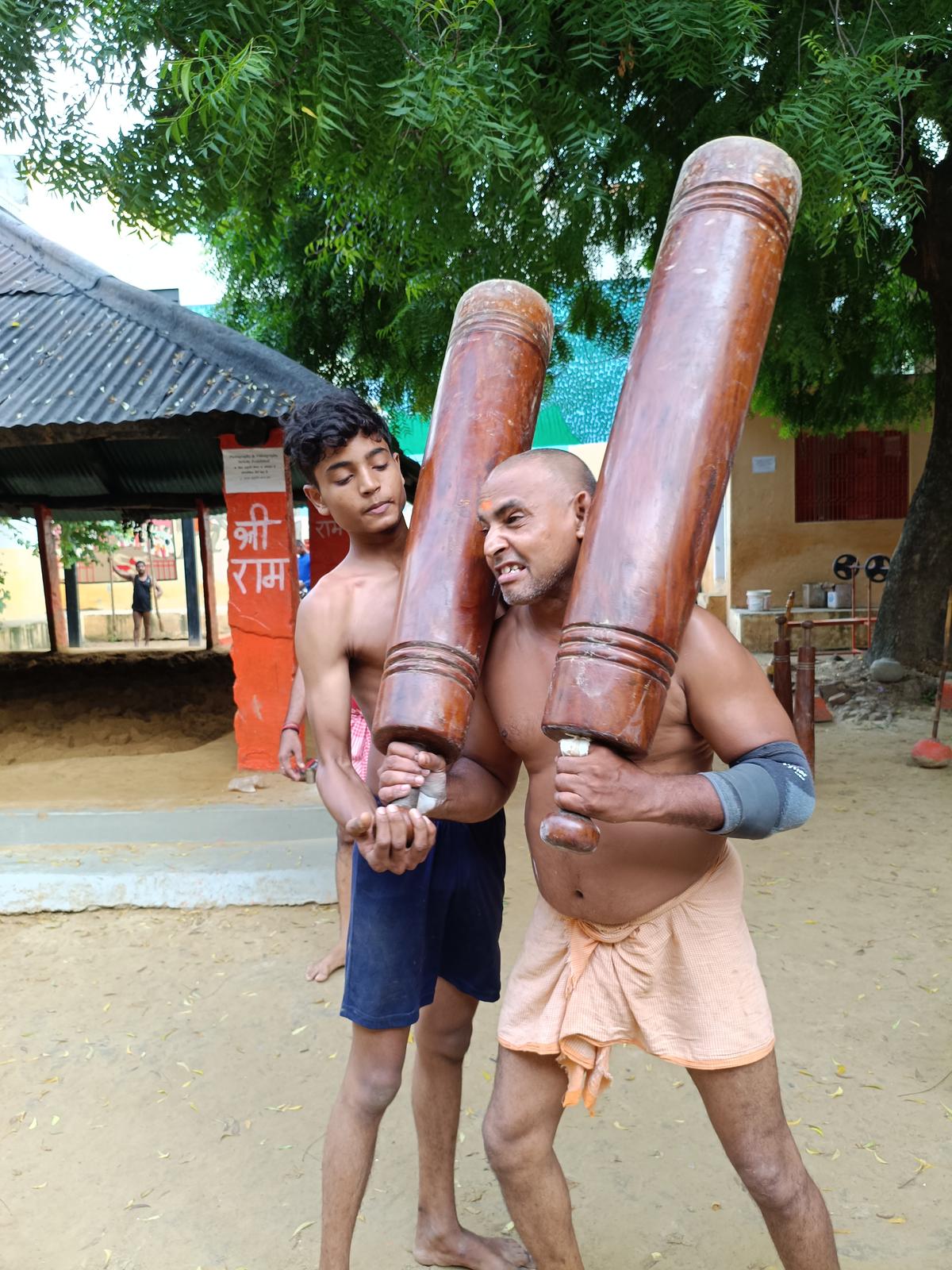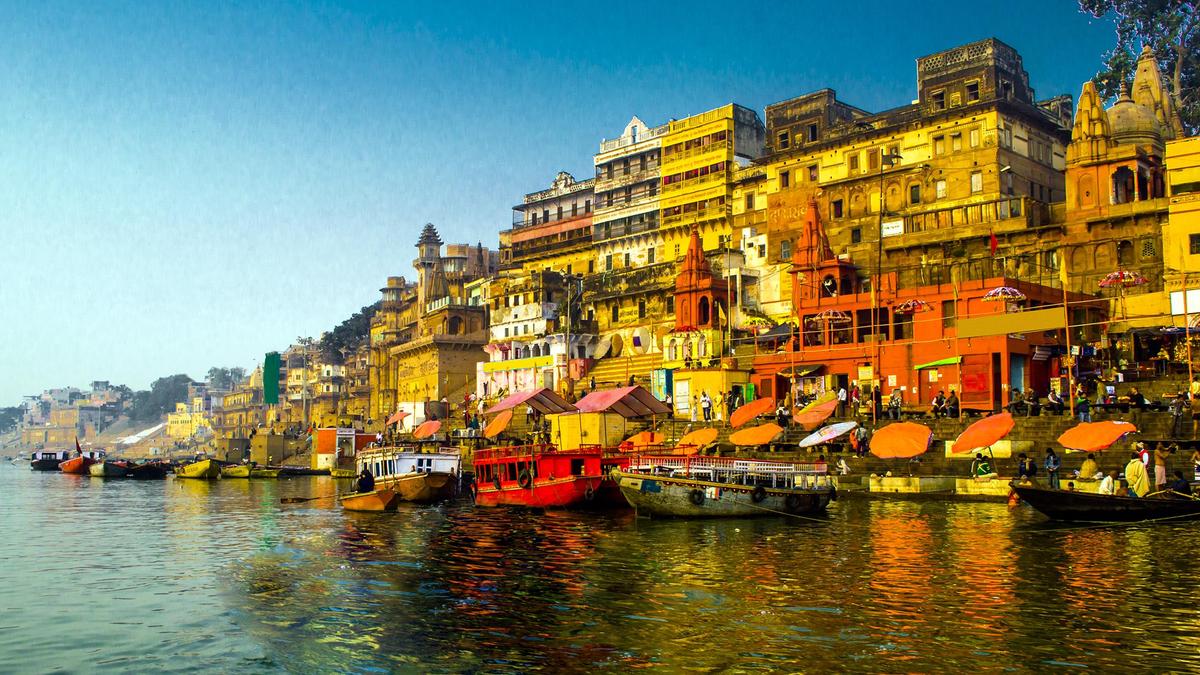Varanasi is awake.
Even before the morning sun’s rays hit Varanasi’s ghats, the Ganga Aarthi begins. Replete with chanting of hymns, this aarthi, an everyday ritual, is an offering to the magnificent river.
On its banks, a rare quiet envelopes Assi Ghat. Someone is chanting ‘Om’. A few yards away, someone else is offering a surya namaskar to the rising sun. This quaint ghat gets its name from the legend of Devi Durga throwing down her sword (‘asi’ in Sanskrit) after slaying demon-brothers Shumbh-Nishumbh, thus creating a river named Asi; it is considered among the most sacred in this town.
These still mornings offer Varanasi’s finest moments. You can gaze at the calm Ganga, or watch industrious boatmen. Or, like actor Dhanush in the romantic Bollywood film Raanjhana, parts of which were shot here, wander through these colourful, chaotic streets.

The early morning aarthi at Varanasi
| Photo Credit:
Srinivasa Ramanujam
“There’s a local myth that these neighbourhoods were all part of a big forest, and hence “van ras” lent its name to the place,” says Pulkit Gupta, who runs Banaras Lanes, which curates walking tours and experiences, “For many, this is the place for spirituality, education and finding the right method of leading life.”
The narrow gullies here have a thousand stories to tell, each echoing with myth and history. They prompted celebrated writer Mark Twain to describe the town as, “older than history, older than tradition, older even than legend and looks twice as old as all of them put together.”
Varanasi – also known as Banaras or Kashi – has 84 ghats right now, with four built in recent times by the government. About 80 were built by different rulers, most from the Maratha empire. Explains Pulkit, “Every king wanted the ghat that they possessed to have a certain style of architecture that resembled what prevailed in their kingdoms. They would come here once in every year to perform certain rituals, and when they left, a few people would be left behind as caretakers.” Thus there are families that have lived in the ghats for many generations.
This also explains the many festivals that are celebrated throughout the year in Varanasi. As Pulkit says, “In the 365 days of a year, there are 366 festivals here.”

Street food at Varanasi
| Photo Credit:
Srinivasa Ramanujam
Spiritual awakening
To get a heady dose of celebration, look no further than the famous Kasi Viswanath, the city’s spiritual pulse that finds a mention in many sacred books, including the Skanda Purana. Destroyed and rebuilt over centuries, it remains the place Kasi is most famously associated with.

We visit at around 10.30 pm, as the temple gears up for shayan aarthi, an almost-informal good night gesture to the gods. Organised by local residents and not yet on things-to-do-in-Varanasi travel lists, the shayan aarthi is an audio visual experience. Hundreds of devotees chant a set of hymns in unison, almost like a choir. And the most beautiful aspect is none of these hymns are written, according to Abhisek Mishra, a Varanasi-based pandit, “While there are set hymns for other pujas in the temple, the recitation during the shayan aarthi has been composed and devised by the local residents. Over the years, it has been passed on through younger devotees.” Indeed there are many of them, as they cry ‘Hara Hara Mahadev’, looking upwards and with both their hands raised in devotion and gratitude.

Tulsi Ghat Akhada at Varanasi
| Photo Credit:
Srinivasa Ramanujam
Fight club
As thousands work on their souls in Varanasi, there’s also work happening on the body on the banks of the Ganges. At the Tulsi Ghat Akhada, a traditional Indian-style gym established in the 16th century and one of the oldest functioning akhadas, young men train under experienced fighters learning martial arts and mud wrestling.
When we visit we watch a young student place a mudgar – or the wooden club, usually used to build strength and endurance – on Sharma G shoulders. “Traditionally, this akhada, which was functional even during the time of celebrated poet Tulsidas in the 16th century, used to train warriors and prepare young men for protection of pilgrimage routes,” he reveals, after lifting the 25-kg mudgar more than 25 times, an act that draws awe and praise among his fellow trainers.
Today, many young boys and girls come here to strength training and learn gusthi for local tournaments. While its mud pits sees several friendly bouts daily, the dands and baithaks that practitioners indulge in every day help in keeping up stamina. A custodian of traditional indigenous forms of physical training and the traditional guru-sishya method of education, the Tulsi Ghat Akhada is a reminder of Varanasi’s physical culture, which held as much value as its spirituality.

‘Chachi ki Dukhaan’ at Varanasi
| Photo Credit:
Srinivasa Ramanujam
Food for thought
The Varanasi of today also offers rich heritage experiences to travellers. Many properties have sprung up near the ghats, like the recently-opened juSTa Kashi Parampara, a 80-year-old ancestral home, which offers experiences such as a traditional aarthi welcome, daily live musical performances and boat rides in the Ganges.
We try tangy samosa chaat – freshly fried and crushed with chole – at the popular Vishwanath Chaat Bhandar. For breakfast, we head to the ‘Chachi Ki Dukhaan’, a street-style eatery established in 1915. Sitting on oil tins that double up as seats, we sample the classic Banarasi breakfast trinity: kachoris, sabzi and jalebi. “The story goes that an old lady – fondly called ‘chachi’ by the locals – used to run this place and kept cussing passersby. Over time, it rose in popularity because of its street-style seating and tangy taste. It is even today called ‘Chachi Ki Dukhaan’,” reveals Pulkit. Glass of fresh lassi from the hallowed Pehalwan Lassi, long favoured by local wrestlers for nourishment after hours of intense training, follow.
Lassi and kachoris done, we head out to explore the busy streets, replete with constant honking and activity. For, Varanasi is awake.
(The writer was in Banaras at the invitation of jüSTa Kashi Parampara)

